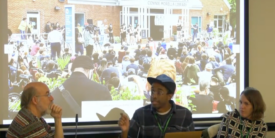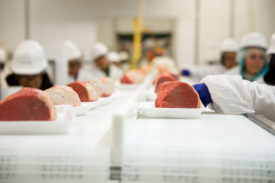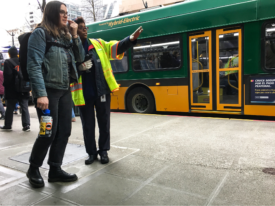Clark:
Researchers believe that the world’s large subway systems are gradually converging on an ideal form:
Roughly half the stations in any subway will be found on its outer branches rather than the core. The distance from a city’s center to its farthest terminus station is twice the diameter of the subway system’s core. This happens again and again.
Sure, it’s possible that the world’s big subway system designers are simply copying one another. Yet the topology of each subway system has evolved independently; many started out with remarkably different configurations, and yet as they’ve gotten larger, they’ve grown to resemble each other more, rather than less. It’s almost as if there’s a hidden dynamic that governs the design of an efficient transportation system. Interestingly, some researchers find that brainless slime molds create transportation networks that look a lot like our own—which suggests that convergent design may be as much about basic geometry as about human foibles.
I hadn’t been aware of the emerging field of experimental philosophy—which uses the empirical results from psychology, sociology, medicine, and applied math to study basic questions of morality, which traditional philosophers tend to ponder from the armchair rather than the lab bench. Consider the so-called “Knobe Effect” (see the middle of this article for a description), which concerns the way in which people apportion credit and blame:
Joshua Knobe’s best-known contribution to experimental philosophy [is based on work] he conducted in New York City’s Washington Square Park. It was a question of intentionality, based on the following scenario: A proposed new product will increase profits, but at the cost of harming the environment. Declaring that he cares about money and not the environment, the head of a company gives the go-ahead to make the product. As expected, profits rise, as does environmental damage. So Knobe asked survey respondents if the executive was to blame for harm to the environment, and 82 percent said yes.
Now imagine the same scenario, with one key difference: The new product helps rather than hurts the environment. The executive still cares just about profits, so the new product goes forward and the money rolls in. But when asked if the executive had helped the environment, only 23 percent of Knobe’s respondents gave him credit for that.
According to Knobe’s results, people are far quicker to assign blame than hand out credit. The tilt towards blame may be irrational, but it’s very real. After all, people working for social change often find it hard to mobilize people to solve a problem unless they can identify a specific villain: a real person whose callous or selfish behavior has caused others to suffer. But so often, problems have no real villains: it’s the system—the rules of governance, or the subtle economic incentives built into the DNA of the economy—that’s to blame for the problem. Our penchant for assigning blame helps explain why “villainless” problems don’t get the attention they deserve…and may also contribute to the fact that people of all political stripes are over-eager to assign blame to political opponents.
Migee:
Need access to Wi-Fi? Is it time to charge your electric car? Tired of looking at ugly cell phone towers? Well, Canadian novelist Douglas Coupland may have the answer—at least for Vancouver, British Columbia. Go find yourself a “Candy Land-like” V-Pole!
Anna:
A Scottish nine-year old’s school lunch blog shames her school into making changes! I love it! As Grist reports, “For each of her lunches, Martha rated taste, healthiness, and pieces of hair (usually zero but not always).” She only had five posts up before media attention, including kudos from chef and food activist Jamie Oliver, started making her school very nervous. (One day she reported: “Last Thursday I went to a small radio studio in Oban and recorded an interview with a BBC radio programme….325,000 people have visited the blog now.”)
Plus, kids from around the world submitted photos of their own sorry school lunches to post on her blog (In one post she writes: “Today my blog has become massive in Taiwan…”)
In the end, she secured unlimited fruit and salad everyday in her cafeteria.
Meanwhile, Michelle Obama just announced a recipe contest for children: The Healthy Lunchtime Challenge.
Finally: Got dirty laundry? Take it to the neighbors’. We’ve seen other smart peer-to-peer sharing platforms—car sharing, vacant bedrooms for hire, and tool libraries. Now a French online service helps families rent out their laundry machines!
Eric dP:
Hands down, the best piece I read this week was Dave Roberts on coal.
In their new digs at Crosscut, Erica C. Barnett and Josh Feit produced a classic-for-the-genre, “Seattle Times wins fight against density.” It was a much-needed antidote to some rather poisonous rhetoric around town, “implying that Mayor Mike McGinn and the council are in thrall to a secret cabal of developers who dictate city policy,” as Erica and Josh aptly put it.
That said, I was pleased to see this Seattle Times editorial praising Seattle’s more cost-effective (and greener!) approach to managing stormwater runoff than regulators have traditionally called for.
Also at the Seattle Times was a terrific piece by Sandi Doughton on the neuroscience of local songbirds:
…nothing in the human brain comes close to the transformation male birds undergo as they ride a roller coaster of hormones that peaks this time of year… …a spring spike in testosterone causes the parts of the brain that control song to double or triple in size.
In the white-crowned sparrows Brenowitz studies, the birds’ vocal skills improve in concert with the changes inside their heads. In winter, their songs are scratchy and jumbled. By early March, everyone is following the appropriate score and performing like Pavarotti.
“If you go out now,” Brenowitz said, “the songs are clean, they’re crisp and they’re beautiful to listen to.”
Whether you’re a bird nut (as I am) or not, it’s a fascinating read.
Finally, I have to say that easily the best $5 I’ve spent recently was the Kindle edition of Jon Raymond’s “Livability.” His writing is clearly rooted in Oregon’s physical geography, but as it traces the human geography of Portland and beyond I found myself enjoying each story more than the one before it. I couldn’t put it down.







